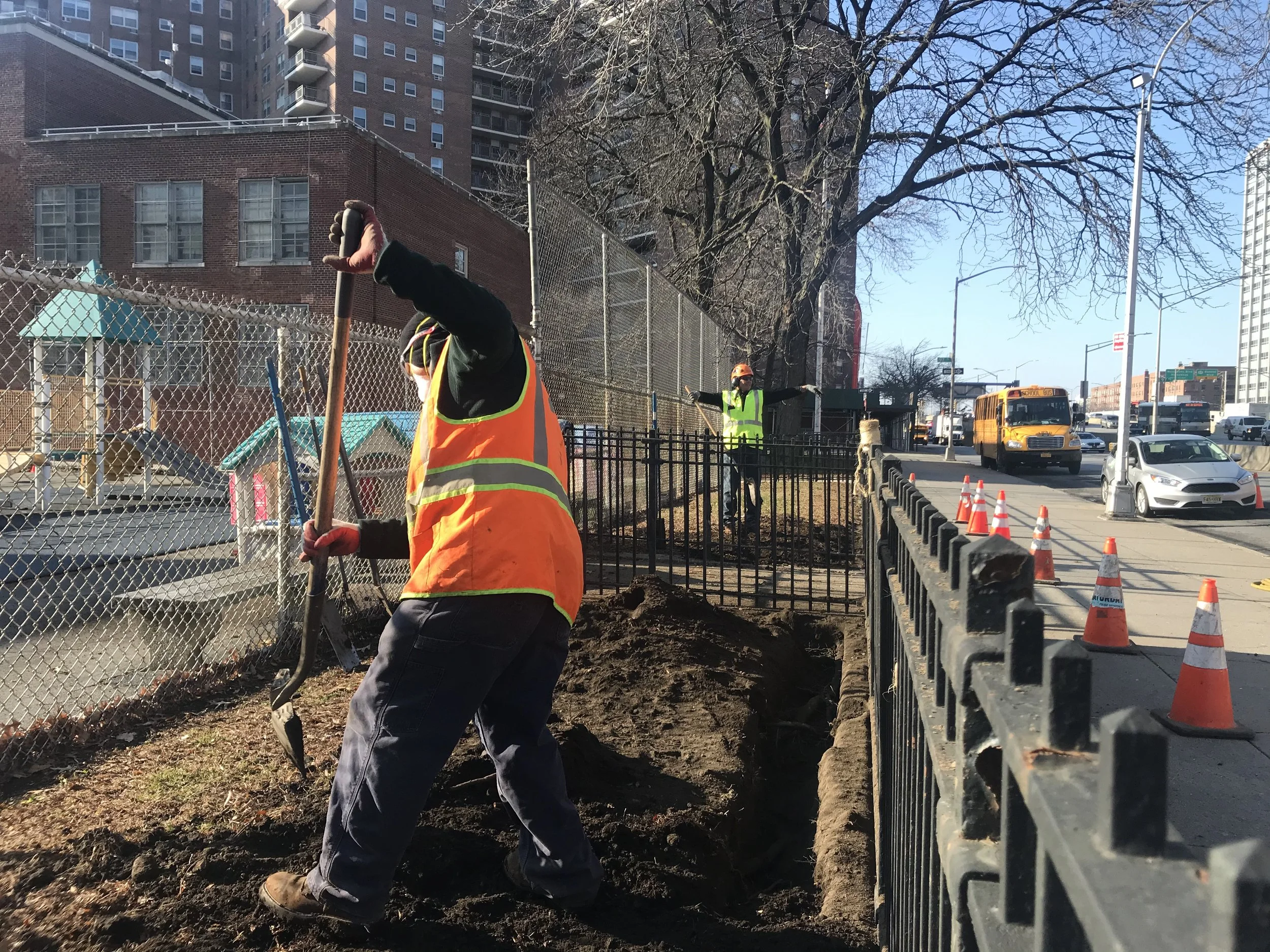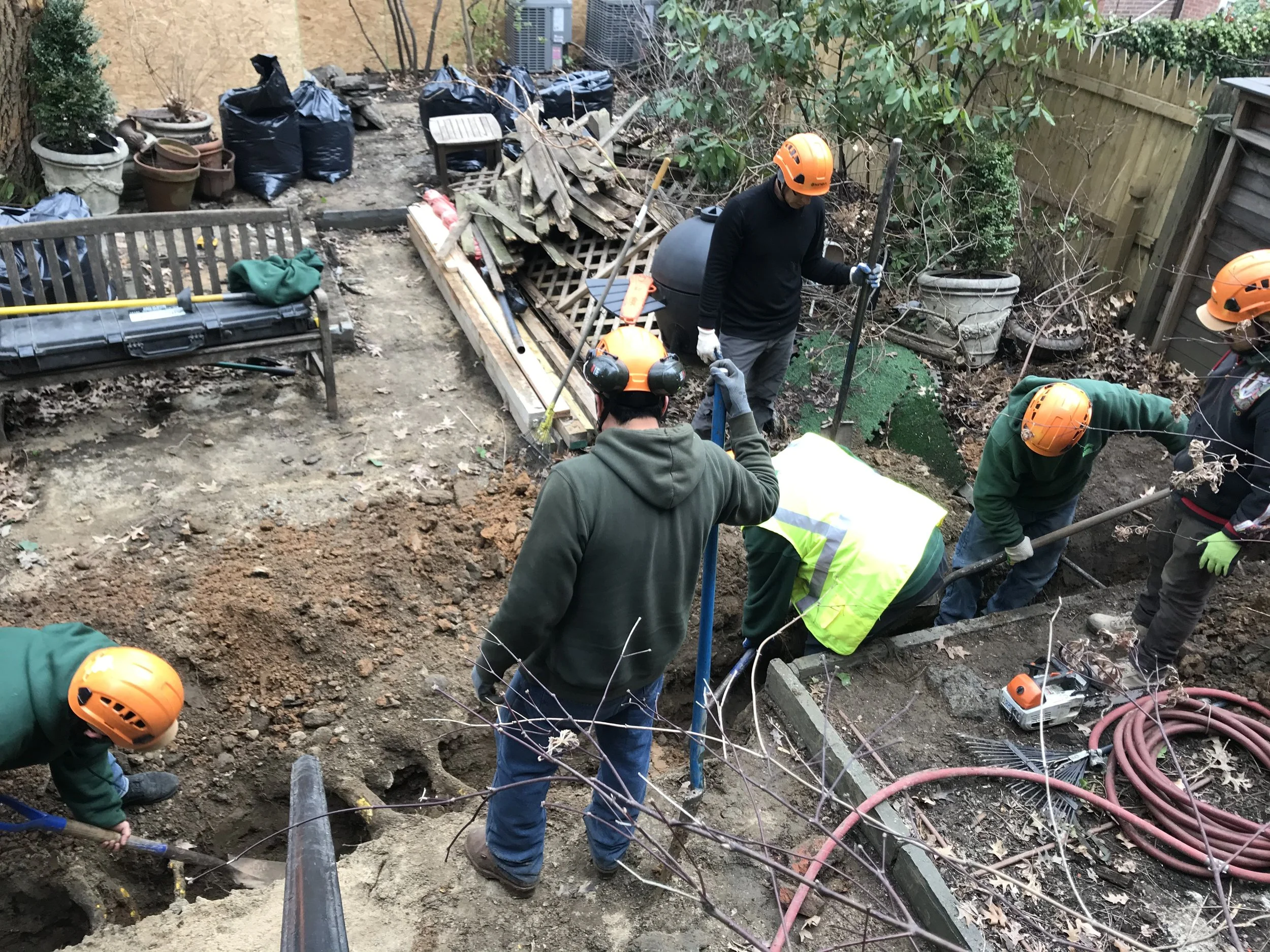Planting
From March through May and from October through December, we plant at every scale, from a single backyard specimen, to a whole garden of woody plants, to a street allee of half a dozen trees, to plantings of hundreds of trees meant to reduce Urban Heat Island Effect. Urban Arborists has been instrumental in the effort to replace trees lost to the Asian Longhorn Beetle.
Root Care
Sometimes roots are unable to serve trees for different reasons. They may be growing in a circular pattern around a tree’s stem and cutting off tree circulation, or they may have been buried and unable to function for lack of oxygen. Sometimes fine roots can become so dense in a planter that we need to create narrow holes for air and water to circulate. Our team knows what to look for when they perform root crown investigations, and they know how to mitigate these sorts of problems so that roots can grow better and take up more nutrients and water from the soils.
Soil Remediation
Construction can damage soils by compacting them and impeding the circulation of water and gases within a tree’s root zone. It can also alter the chemical makeup of soils. While soil replacement is sometimes necessary, Urban Arborists can decompact with a pneumatic air tool and amend soils, supporting the life of existing trees. The organic amendments we provide boost the populations and activity of decomposers and beneficial microbes, promote root-fungi symbiosis that enhances uptake of water and nutrients, and stimulate new root production to induce systemic resistance to pests and pathogens. We are experts at soil assessment and remediation. We may adjust anything from soil biologicals, to pH, to texture, to organic matter, depending upon the needs of the plants.
Design
Although we refer clients who need whole gardens planned to several designers whom we admire and trust, Urban Arborists loves to do our own woody plant design. Bill Logan's experience writing about gardens—together with his two decades of experience caring for gardens and trees—has given him skill in fitting beautiful combinations of trees and shrubs into existing settings, whether woodland gardens, city spaces, or suburban landscapes.
Pruning
There are many reasons to prune: to make a tree safer, to repair damage, to get branches out of the way, to improve a tree's structure or health, to improve a shrub's flowering or its shape, to please the neighbors. But in every single case, pruning is an art. We make the tree or the shrub more fitting for its place and purpose. We make it a part of the genius of its place. Before we touch any plant, we discuss the purpose with our clients. We prune the minimum necessary to achieve that goal. We follow the physician creed, First Do No Harm.
We have a particular interest in formal pruning. Ornamental pollarding, coppicing, and aerial hedging are all areas where we have particular expertise.
Tree emergencies
In the aftermaths of both Irene and Superstorm Sandy, Urban Arborists was able to mobilize immediately to help alleviate and clean up in suddenly precarious environments at residences, open spaces and institutions. In the case of Sandy, we rescued our trucks ahead of the storm surge that incapacitated Red Hook (where our office and yard are located) and operated out of a temporary space. In some cases, enormous trees were made unstable or had fallen on people’s homes, and we gained valuable additional experience working with a trusted crane operator in cases where our equipment could not do the job alone. Though we never wish to see such a storm strike our area again, we are ready to serve our clients when they need us.
Treatment
Urban Arborists will never place cover sprays to attack unspecified pests on a large number of trees and shrubs. We target specific treatments for specific pests on specific plants, only taking action after diagnosis is made. We only treat when we observe that the antagonist is present in sufficient numbers to cause harm, and we treat only when that pest is vulnerable. In some cases, we will suggest doing nothing at all. Where treatments are necessary, we look for the least toxic alternative. There are oils, soaps and more serious pesticides, but sometimes a good jet of plain water will do the job. For Dutch elm disease and the insects that spread it, on the other hand, only a relatively toxic systemic will do. We follow biorational guidelines for all our work, and we offer strictly organic options upon request.
Cabling
Cables and braces in trees can help to prevent failures of weak or very large branches or leaders in wind and storm. Urban Arborists knows which cable to use in which conditions and on which trees. We also know when cabling is not a good idea at all.
Once, all cables were made of 7-strand, galvanized steel and fixed to the tree with J-shaped screws or with through-bolts. Now, there are other kinds of steel cable, as well as several kinds of synthetic cable that may not require drilling into stems. We are also skilled at placing brace and cable combinations to repair weak crotches that have begun to crack. By this means, we can often save trees that would otherwise be lost. We are skilled at making props - often out of wood from the same tree or species - to preserve long, low branches that cannot be effectively pruned to prevent breakage.
Tree Removal
Although we are not fond of removing trees unless it is truly necessary, we are unusually good at difficult removals in tight spaces. As an urban company, we are all too familiar with large dying or dead ailanthus trees, locusts or silver maples located in tiny backyards surrounded with windows, with fine gardens, with prize plants, and with fishponds. We pride ourselves on our ability to extricate such very large and dangerous trees while doing no damage to the fine surroundings.
Transplants
When a valuable, reasonably young tree can no longer remain where it is growing, we can carefully lift it out of its home and place in a new home. Our track record of successful transplants grows every year, and our crew is skilled at working efficiently while taking care to preserve as much as possible of trees’ root systems and preventing crown damage during transit. We regularly transplant trees up to 8-10” DBH, though before any transplant, we will inspect and report on the prospects for success, given not only the size of the tree but the character of the site from which it comes and the new site to which it is going.
Our trees look great!
“Spring clean-ups are much easier now. Urban Arborists removes weak branches before the storms do And our trees look great!”
— J.S., Westchester
Your men did a great job!
“Your men did a great job this morning. They are a thoughtful courteous group of guys and I wanted you to know.”
— L.K., Manhattan
The crew was very good
“The crew was very good, as I have now come to count on, and I am so grateful for Bill's ability to come up with solid solutions to various problem areas. ”
— J.W., Brooklyn
Let us know what you need
Call us for a quote and we'll be happy to reach back to you






